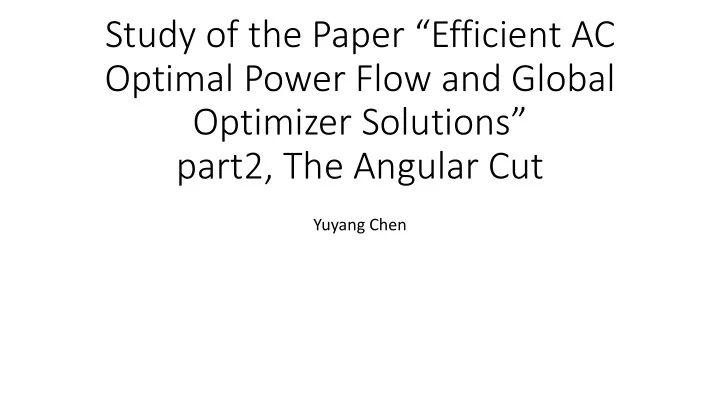

Study of the Paper “Efficient AC Optimal Power Flow and Global Optimizer Solutions” part2, The Angular Cut Yuyang Chen
Presentation Agenda I. Background introduction , review of part 1’s theory II. Primary theoretical studies: how does the angular cut in D&C work, Detail explanations III. Secondary theoretical studies: the effects of additional constraints. IV. Conclusions
I. Background introduction , review of part 1’s theory • In Bai’s paper , SDP relaxation of OPF gives some promising results. But it offers no help when the rank of SDP solution matrix is larger than 2, which is physically meaningless. • In Mitsubishi's B&B method it attempts to address such problem by D&C algorithm type approach. • This paper’s 1 st contribution is the introduction of a Novel angular cut, which increase the effectiveness of D&C method. • This paper’s 2 nd contribution is to guarantee the infeasibility of original OPF if no solution is feasible from GO method. • This paper ‘s method does not required CONOPF , a Non -Linear solver. Note: for simplicity we will refer to the (SDP, D&C , angular cut )method used in this paper as “ GO method ”
I. Background introduction , review of part 1’s theory • Previously , we gave a frame work of GO method : through SDP relaxation of OPF and Divide and Conquer method we can find the Global Optimizer. • Let’s take a closer look at how a efficient branching from parent problem into child problems is achieve through a novel angular cut introduced in this paper
II. Primary theoretical studies: What is the effect of applying D&C , its visualization on OPF feasible region and SDP solution space.
∗ ∗ ∗ 𝑧 𝑗 ∗ ∗ = tan − 1 𝑧 𝑗 ∗ 2 = tan − 1 𝑋 ∗ = tan − 1 𝑦 𝑗 𝑗 , 𝑗 + 𝑂 𝜄 𝑗 ∗ 𝑦 𝑗 𝑋 𝑦 𝑗 𝑗 , 𝑗 ∗ 2 ∗ ∗ = tan − 1 𝑋 ∗ = tan − 1 𝑧 𝑗 𝑗 + 𝑂 , 𝑗 + 𝑂 but Also , 𝜄 𝑗 ∗ 𝑧 𝑗 ∗ 𝑦 𝑗 𝑋 𝑗 , 𝑗 + 𝑂 ∗ ∗ if rank W >1 tan − 1 𝑋 ≠ tan − 1 𝑋 𝑗 + 𝑂 , 𝑗 + 𝑂 𝑗 , 𝑗 + 𝑂 ∗ ∗ 𝑋 𝑋 𝑗 , 𝑗 + 𝑂 𝑗 , 𝑗
• GO method can be more efficient because it exploit the SDP solution when dividing parent problem but B&B did not. • In D&C type approach ( this include both B&B and Go method) ,If parent node solution overlap with child node solution then such algorithm is less efficient and can be improved: • In B&B method parent node solution and child node solutions over lap. In GO method they do not. • Go method do not use CONOPF , a non-linear solver.
III . Secondary theoretical studies: Effects of adding additional constraints without adding additional variables • Adding more constrains to the same set of variables makes the SDP relaxation tighter and therefore easier to compute.
Conclusions & ending remarks
Recommend
More recommend